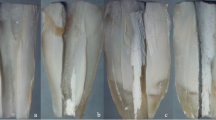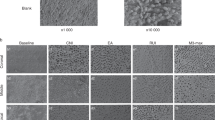Abstract
The aim of this study was to evaluate the removal of the smear layer by some commonly used (needle-and-syringe irrigation, sonic activation, ultrasonically activated irrigation) and new root canal irrigation strategies (negative pressure irrigation and polymer rotary file) using a novel approach by comparing pre- and post-experimental images. Prepared root canals (n = 50) were subjected to a split tooth model and divided into 5 groups (n = 10): (1) needle-and-syringe irrigation (control); (2) sonic activation (SA); (3) negative pressure irrigation with continuous warm activated irrigation and evacuation (CWA); (4) polymer finishing file (FF); (5) ultrasonically activated irrigation (UAI). Smear layer scores and percentage of open dentinal tubules (%ODT) were evaluated by 2 examiners before and after irrigation procedures, from the middle and apical thirds of the root canal, on scanning electron microscopic images. Data were analysed using Kruskal–Wallis and post hoc tests at P = 0.05. Needle-and-syringe irrigation (control) showed no significant difference (both smear score and %ODT) compared to the pre-experimental value (P > 0.05). All other groups showed lower smear scores and higher %ODT, compared to the control (P < 0.05). The lowest smear score and highest %ODT were observed in the CWA group, which was significantly different from all other groups (P < 0.05). SA group showed significantly higher smear scores and lower %ODT than FF or UAI (P < 0.05). CWA showed superior removal of smear layer in the middle and apical thirds of the root canal compared to the other irrigation strategies.

Similar content being viewed by others
References
Wang Z, Shen Y, Haapasalo M. Effect of smear layer against disinfection protocols on Enterococcus faecalis-infected dentin. J Endod. 2013;39:1395–400.
Violich DR, Chandler NP. The smear layer in endodontics—a review. Int Endod J. 2010;43:2–15.
Carvalho AS, Camargo CH, Valera MC, Camargo SE, Mancini MN. Smear layer removal by auxiliary chemical substances in biomechanical preparation: a scanning electron microscope study. J Endod. 2008;34:1396–400.
Ng YL, Mann V, Gulabivala K. A prospective study of the factors affecting outcomes of nonsurgical root canal treatment: part 1: periapical health. Int Endod J. 2011;44:583–609.
Pintor AV, Dos Santos MR, Ferreira DM, Barcelos R, Primo LG, Maia LC. Does smear layer removal influence root canal therapy outcome? A systematic review. J Clin Pediatr Dent. 2016;40:1–7.
Neelakantan P, Devaraj S, Jagannathan N. Histologic assessment of debridement of the root canal isthmus of mandibular molars by irrigant activation techniques ex vivo. J Endod. 2016;42:1268–72.
De-Deus G, Reis C, Paciornik S. Critical appraisal of published smear layer-removal studies: methodological issues. Oral Surg Oral Med Oral Pathol Oral Radiol Endod. 2011;112:531–43.
Lottanti S, Gautschi H, Sener B, Zehnder M. Effects of ethylenediaminetetraacetic, etidronic and peracetic acid irrigation on human root dentin and the smear layer. Int Endod J. 2009;42:335–43.
Mancini M, Cerroni L, Iorio L, Armellin E, Conte G, Cianconi L. Smear layer removal and canal cleanliness using different irrigation systems (EndoActivator, EndoVac, and passive ultrasonic irrigation): field emission scanning electron microscopic evaluation in an in vitro study. J Endod. 2013;39:1456–60.
Blank-Goncalves LM, Nabeshima CK, Martins GH, Machado ME. Qualitative analysis of the removal of the smear layer in the apical third of curved roots: conventional irrigation versus activation systems. J Endod. 2011;37:1268–71.
Schmidt TF, Teixeira CS, Felippe MC, Felippe WT, Pashley DH, Bortoluzzi EA. Effect of ultrasonic activation of irrigants on smear layer removal. J Endod. 2015;41:1359–63.
Tay FR, Gu LS, Schoeffel GJ, Wimmer C, Susin L, Zhang K, Arun SN, Kim J, Looney SW, Pashley DH. Effect of vapor lock on root canal debridement by using a side-vented needle for positive-pressure irrigant delivery. J Endod. 2010;36:745–50.
Hulsmann M, Rummelin C, Schafers F. Root canal cleanliness after preparation with different endodontic handpieces and hand instruments: a comparative SEM investigation. J Endod. 1997;23:301–6.
Vasiliadis L, Darling AI, Levers BG. The amount and distribution of sclerotic human root dentin. Arch Oral Biol. 1983;28:645–9.
Basmadjian-Charles CL, Farge P, Bourgeois DM, Lebrun T. Factors influencing the long-term results of endodontic treatment: a review of the literature. Int Dent J. 2002;52:81–6.
Gu LS, Kim JR, Ling J, Choi KK, Pashley DH, Tay FR. Review of contemporary irrigant agitation techniques and devices. J Endod. 2009;35:791–804.
George S, Kishen A, Song KP. The role of environmental changes on monospecies biofilm formation on root canal wall by Enterococcus faecalis. J Endod. 2005;31:867–72.
Baumgartner JC, Mader CL. A scanning electron microscopic evaluation of four root canal irrigation regimens. J Endod. 1987;13:147–57.
Saunders WP, Saunders EM. The effect of smear layer upon the coronal leakage of gutta-percha fillings and a glass ionomer sealer. Int Endod J. 1992;25:245–9.
Yang SE, Bae KS. Scanning electron microscopy study of the adhesion of Prevotella nigrescens to the dentin of prepared root canals. J Endod. 2002;28:433–7.
Cameron JA. The use of ultrasound for the removal of the smear layer. The effect of sodium hypochlorite concentration; SEM study. Aust Dent J. 1988;33:193–200.
Rodig T, Dollmann S, Konietschke F, Drebenstedt S, Hulsmann M. Effectiveness of different irrigant agitation techniques on debris and smear layer removal in curved root canals: a scanning electron microscopy study. J Endod. 2010;36:1983–7.
Prado M, Gusman H, Gomes BP, Simao RA. Scanning electron microscopic investigation of the effectiveness of phosphoric acid in smear layer removal when compared with EDTA and citric acid. J Endod. 2011;37:255–8.
de Gregorio C, Estevez R, Cisneros R, Paranjpe A, Cohenca N. Efficacy of different irrigation and activation systems on the penetration of sodium hypochlorite into simulated lateral canals and up to working length: an in vitro study. J Endod. 2010;36:1216–21.
Haapasalo M, Shen Y, Wang Z, Gao Y. Irrigation in endodontics. Br Dent J. 2014;216:299–303.
Mozo S, Llena C, Forner L. Review of ultrasonic irrigation in endodontics: increasing action of irrigating solutions. Med Oral Patol Oral Cir Bucal. 2012;17:e512-6.
Jiang LM, Verhaagen B, Versluis M, van der Sluis LW. Evaluation of a sonic device designed to activate irrigant in the root canal. J Endod. 2010;36:143–6.
Moorer WR, Wesselink PR. Factors promoting the tissue dissolving capability of sodium hypochlorite. Int Endod J. 1982;15:187–96.
Saber Sel D, Hashem AA. Efficacy of different final irrigation activation techniques on smear layer removal. J Endod. 2011;37:1272–5.
Wu L, Mu Y, Deng X, Zhang S, Zhou D. Comparison of the effect of four decalcifying agents combined with 60 °C 3% sodium hypochlorite on smear layer removal. J Endod. 2012;38:381–4.
Khademi A, Yazdizadeh M, Feizianfard M. Determination of the minimum instrumentation size for penetration of irrigants to the apical third of root canal systems. J Endod. 2006;32:417–20.
Lee SJ, Wu MK, Wesselink PR. The efficacy of ultrasonic irrigation to remove artificially placed dentin debris from different-sized simulated plastic root canals. Int Endod J. 2004;37:607–12.
Capar ID, Aydinbelge HA. Effectiveness of various irrigation activation protocols and the self-adjusting file system on smear layer and debris removal. Scanning. 2014;36:640–7.
Malki M, Verhaagen B, Jiang LM, Nehme W, Naaman A, Versluis M, Wesselink P, van der Sluis L. Irrigant flow beyond the insertion depth of an ultrasonically oscillating file in straight and curved root canals: visualization and cleaning efficacy. J Endod. 2012;38:657–61.
Sabins RA, Johnson JD, Hellstein JW. A comparison of the cleaning efficacy of short-term sonic and ultrasonic passive irrigation after hand instrumentation in molar root canals. J Endod. 2003;29:674–8.
Klyn SL, Kirkpatrick TC, Rutledge RE. In vitro comparisons of debris removal of the EndoActivator system, the F file, ultrasonic irrigation, and NaOCl irrigation alone after hand-rotary instrumentation in human mandibular molars. J Endod. 2010;36:1367–71.
Mader CL, Baumgartner JC, Peters DD. Scanning electron microscopic investigation of the smeared layer on root canal walls. J Endod. 1984;10:477–83.
White RR, Goldman M, Lin PS. The influence of the smeared layer upon dentinal tubule penetration by endodontic filling materials. Part II. J Endod. 1987;13:369–74.
Acknowledgements
The authors sincerely thank Ms. Samantha Kar Yan Li, Centralized Research Laboratories, Faculty of Dentistry, The University of Hong Kong for the data analysis.
Funding
This study did not receive any funding from internal or external sources.
Author information
Authors and Affiliations
Corresponding author
Ethics declarations
Conflict of interest
The authors declare that they have no conflict of interest.
Rights and permissions
About this article
Cite this article
Neelakantan, P., Ounsi, H.F., Devaraj, S. et al. Effectiveness of irrigation strategies on the removal of the smear layer from root canal dentin. Odontology 107, 142–149 (2019). https://doi.org/10.1007/s10266-018-0373-2
Received:
Accepted:
Published:
Issue Date:
DOI: https://doi.org/10.1007/s10266-018-0373-2




